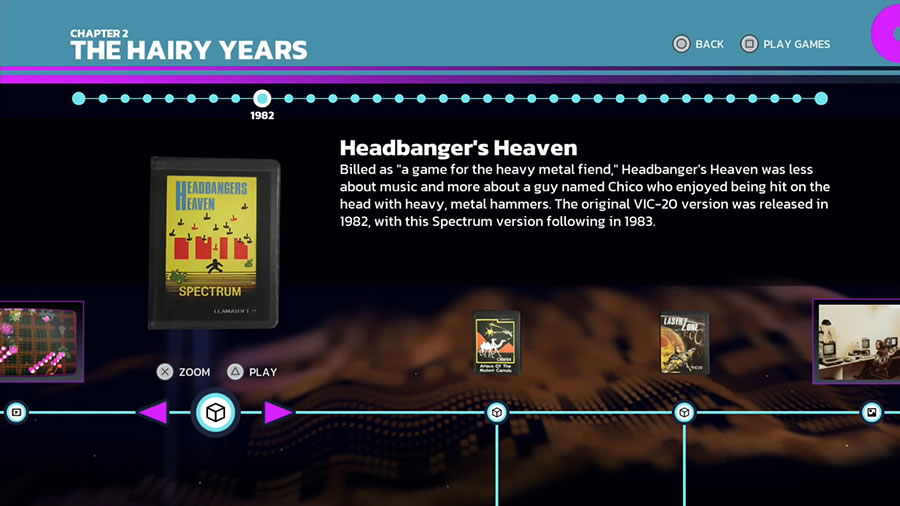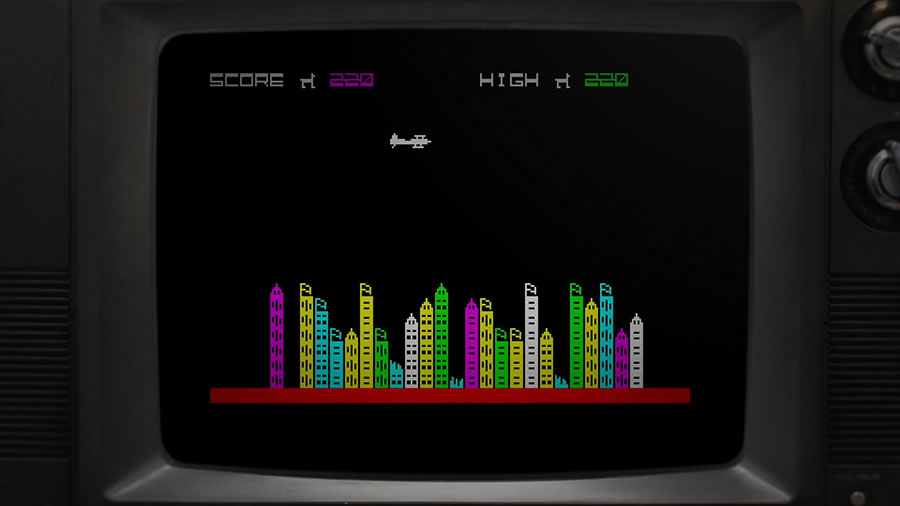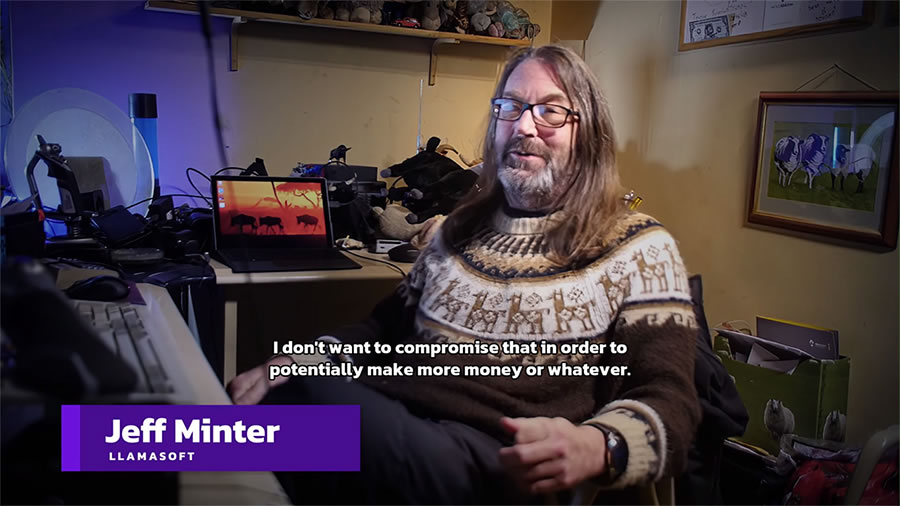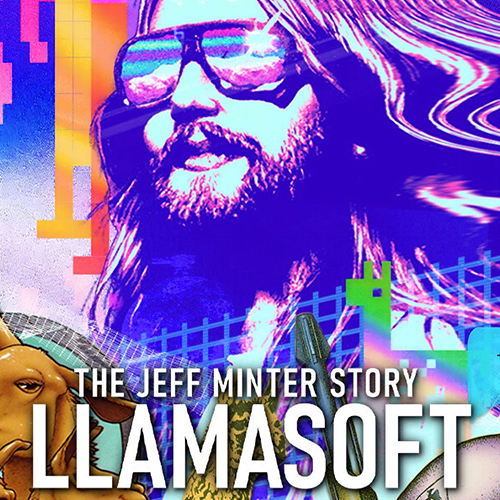- CLASSIC MAGAZINES
- REVIEW CREW
A show recapping what critics thought back
when classic games first came out! - NEXT GENERATION'S BEST & WORST
From the worst 1-star reviews to the best
5-stars can offer, this is Next Generation! - NINTENDO POWER (ARCHIVE)
Experience a variety of shows looking at the
often baffling history of Nintendo Power! - MAGAZINE RETROSPECTIVE
We're looking at the absolutely true history of
some of the most iconic game magazines ever! - SUPER PLAY'S TOP 600
The longest and most ambitious Super NES
countdown on the internet! - THEY SAID WHAT?
Debunking predictions and gossip found
in classic video game magazines! - NEXT GENERATION UNCOVERED
Cyril is back in this spin-off series, featuring the
cover critic review the art of Next Generation! - HARDCORE GAMER MAGAZING (PDF ISSUES)
Download all 36 issues of Hardcore Gamer
Magazine and relive the fun in PDF form!
- REVIEW CREW
- ELECTRONIC GAMING MONTHLY
- ELECTRONIC GAMING MONTHLY RANKS
From Mario to Sonic to Street Fighter, EGM
ranks classic game franchises and consoles! - ELECTRONIC GAMING MONTHLY BEST & WORST
Counting down EGM’s best and worst reviews
going year by year, from 1989 – 2009! - ELECTRONIC GAMING BEST & WORST AWARDS
11-part video series chronicling the ups and
downs of EGM’s Best & Worst Awards!
- ELECTRONIC GAMING MONTHLY RANKS
- GAME HISTORY
- GAME OVER: STORY BREAKDOWNS
Long-running series breaking down game
stories and analyzing their endings! - A BRIEF HISTORY OF GAMING w/ [NAME HERE]
Real history presented in a fun and pithy
format from a variety of game historians! - THE BLACK SHEEP
A series looking back at the black sheep
entries in popular game franchises! - INSTANT EXPERT
Everything you could possibly want to know
about a wide variety of gaming topics! - FREEZE FRAME
When something familiar happens in the games
industry, we're there to take a picture! - I'VE GOT YOUR NUMBER
Learn real video game history through a series
of number-themed episodes, starting at zero! - GREAT MOMENTS IN BAD ACTING
A joyous celebration of some of gaming's
absolute worst voice acting!
- GAME OVER: STORY BREAKDOWNS
- POPULAR SHOWS
- DG NEWS w/ LORNE RISELEY
Newsman Lorne Riseley hosts a regular
series looking at the hottest gaming news! - REVIEW REWIND
Cyril replays a game he reviewed 10+ years
ago to see if he got it right or wrong! - ON-RUNNING FEUDS
Defunct Games' longest-running show, with
editorials, observations and other fun oddities! - DEFUNCT GAMES QUIZ (ARCHIVE)
From online quizzes to game shows, we're
putting your video game knowledge to the test!- QUIZ: ONLINE PASS
Take a weekly quiz to see how well you know
the news and current gaming events! - QUIZ: KNOW THE GAME
One-on-one quiz show where contestants
find out if they actually know classic games! - QUIZ: THE LEADERBOARD
Can you guess the game based on the classic
review? Find out with The Leaderboard!
- QUIZ: ONLINE PASS
- DEFUNCT GAMES VS.
Cyril and the Defunct Games staff isn't afraid
to choose their favorite games and more! - CYRIL READS WORLDS OF POWER
Defunct Games recreates classic game
novelizations through the audio book format!
- DG NEWS w/ LORNE RISELEY
- COMEDY
- GAME EXPECTANCY
How long will your favorite hero live? We crunch
the numbers in this series about dying! - VIDEO GAME ADVICE
Famous game characters answer real personal
advice questions with a humorous slant! - FAKE GAMES: GUERILLA SCRAPBOOK
A long-running series about fake games and
the people who love them (covers included)! - WORST GAME EVER
A contest that attempts to create the worst
video game ever made, complete with covers! - LEVEL 1 STORIES
Literature based on the first stages of some
of your favorite classic video games! - THE COVER CRITIC
One of Defunct Games' earliest shows, Cover
Critic digs up some of the worst box art ever! - COMMERCIAL BREAK
Take a trip through some of the best and
worst video game advertisements of all time! - COMIC BOOK MODS
You've never seen comics like this before.
A curious mix of rewritten video game comics!
- GAME EXPECTANCY
- SERIES ARCHIVE
- NINTENDO SWITCH ONLINE ARCHIVE
A regularly-updated list of every Nintendo
Switch Online release, plus links to review! - PLAYSTATION PLUS CLASSIC ARCHIVE
A comprehensive list of every PlayStation
Plus classic release, including links! - RETRO-BIT PUBLISHING ARCHIVE
A regularly-updated list of every Retro-Bit
game released! - REVIEW MARATHONS w/ ADAM WALLACE
Join critic Adam Wallace as he takes us on a
classic review marathon with different themes!- DEFUNCT GAMES GOLF CLUB
Adam Wallace takes to the links to slice his way
through 72 classic golf game reviews! - 007 IN PIXELS
Adam Wallace takes on the world's greatest spy
as he reviews 15 weeks of James Bond games! - A SALUTE TO VAMPIRES
Adam Wallace is sinking his teeth into a series
covering Castlevania, BloodRayne and more! - CAPCOM'S CURSE
Adam Wallace is celebrating 13 days of Halloween
with a line-up of Capcom's scariest games! - THE FALL OF SUPERMAN
Adam Wallace is a man of steel for playing
some of the absolute worst Superman games! - THE 31 GAMES OF HALLOWEEN
Adam Wallace spends every day of October afraid
as he reviews some of the scariest games ever! - 12 WEEKS OF STAR TREK
Adam Wallace boldly goes where no critic has
gone before in this Star Trek marathon!
- DEFUNCT GAMES GOLF CLUB
- DAYS OF CHRISTMAS (ARCHIVE)
Annual holiday series with themed-episodes
that date all the way back to 2001!- 2015: 30 Ridiculous Retro Rumors
- 2014: 29 Magazines of Christmas
- 2013: 29 Questionable Power-Ups of Christmas
- 2012: 34 Theme Songs of Christmas
- 2011: 32 Game Endings of Christmas
- 2010: 31 Bonus Levels of Christmas
- 2009: 30 Genres of Christmas
- 2008: 29 Controls of Christmas
- 2007: 34 Cliches of Christmas
- 2006: 33 Consoles of Christmas
- 2005: 32 Articles of Christmas
- 2004: 31 Websites of Christmas
- 2003: 29 Issues of Christmas
- 2002: 28 Years of Christmas
- 2001: 33 Days of Christmas
- NINTENDO SWITCH ONLINE ARCHIVE
- REVIEW ARCHIVE
- FULL ARCHIVE
Llamasoft: The Jeff Minter Story
These days, it seems like every developer is trying to create the most photorealistic action heroes possible, complete with wrinkles, laugh lines and those tiny face hairs you only notice if you’re standing uncomfortably close to somebody. That does NOT describe Jeff Minter, the legendary and insanely influential game developer who filled his games with sheep, camels and a whole bunch of llamas. His unique point-of-view is front and center in Llamasoft: The Jeff Minter Story, an interactive documentary and museum exhibition that collects more than fourty of his best games, including a handful of rare finds from his early days as a developer. This is the newest video game compilation from Digital Eclipse, the company behind last year’s amazing Making of Karateka, as well as the surprisingly sprawling Atari 50 celebration. Is this another high-water mark for the masters of game preservation? That’s what we’re about to find out as we take a tour of the farm in Llamasoft: The Jeff Minter Story, the newest entry in the Gold Master Series.
Jeff Minter is not your typical game developer. This much is clear the moment you start this impressive new game compilation. Sporting long hair and living on a llama farm somewhere in Wales, Jeff is described by his friends and colleagues as a rebel and a rock star. He’s the rare example of a developer who has somehow managed to buck the system, yet still prosper in an ever-changing industry that seems designed to stamp out people like him. For more than fourty years, Jeff has been able to cut his own path and make the quirky games that he wants to play, and this new interactive documentary takes us on a journey of his rise to prominence and what it took to keep the Llamasoft dream alive for so many years.
The first thing you need to know is that Llamasoft: The Jeff Minter Story is the second game in Digital Eclipse’s Gold Master Series. This means that the interface and general approach is almost identical to what we saw from The Making of Karateka. This is a compilation that takes us year by year through Jeff Minter’s career, from the early days where he’s making games in his parent’s garage right up to him releasing Tempest 2000 on the Atari Jaguar, the franchise he is best-known for.
As we go through the months and years, we’ll watch video clips revealing how each game came to be, as well as looking at the artwork, cassette tapes and instruction manuals associated with each title. Sometimes there will be cool extras, like the notes he kept when coming up with the idea and the way they advertised it at the time. We get further context as the timeline reveals critical reviews and interviews with the British gaming press in the 1980s. One of the coolest extras in this compilation is the newsletter Jeff wrote and sent out to fans, allowing us a rare chance to see what he thought at the time about his own games and where the industry was headed in general.
What sets this apart from The Making of Karateka is the struggle and the grind. Where the previous entry was about the process of making one of the most influential games of all time, The Jeff Minter Story is more about what it takes to stay afloat in this industry, from making dozens of unique games to getting people to buy them.
With his long hair and rebellious attitude, it’s easy to compare Jeff’s story to a rock star. Here’s a guy who got his start making games in his parent’s garage, imitating the popular games at the time in both subtle and blatant ways. It was a time when a developer could sell their no-budget titles on cassette tape at local computer shows and make enough money to fund the next idea. And that’s what Jeff did, slowly building up a fan base and finding his own voice as a game designer. Along the way, Jeff has to deal with bad business partners, publishers going bankrupt, game systems never coming out and an industry that sometimes feels out-of-step with the kinds of games he wants to make, and yet he continues to come out on top more than four decades later.
What’s exciting is that we finally have a way to play many of Llamasoft’s earliest games; the ones that shaped Jeff as a game-maker. I’m talking about the weird first-person maze game 3D3D, the rodent killing game Ratman and City Bomber, a controversial game satirizing the war in Argentina. This makes way to more traditional titles, like the Space Invaders-influenced Abductor, the Defender-influenced Andes Attack and the Blade Runner-inspired action game Gridrunner, which proved to be Llamasoft’s first big hit.
This is the big turning point for the company, as Jeff starts to show off his own quirky personality with titles like Attack of the Mutant Camels, Metagalactic Llamas Battle at the Edge of Time and, of course, Sheep in Space. These titles were still inspired by many of the arcade hits of the era, but always had a quirky sense of humor and would usually twist the formula in some fun ways. And just like The Making of Karateka, we get to see many of these games across multiple formats, allowing us to choose which version we prefer to play.
While there are a few games that I will likely never go back to, there are also some real gems here. A big surprise for me was Hover Bovver, a game where you steal some poor sap’s lawnmower and you attempt to mow the entire lawn before he (and his dog) catch you. Another great game was the company’s first foray into shareware, Llamatron: 2112, a Robotron parody with some of the most random enemies you’ve ever seen. I was also blown away by Attack of the Mutant Camels ’89, which was set to come out on the canceled Konix Multi-System. When the company canceled the console, Llamasoft stopped working on the game, but what is here is an absolute blast, even in its incomplete form. This is easily the best version of the Mutant Camel saga, and it’s a shame it was never completed and released on the Atari Jaguar.
Speaking of the Jaguar, we can’t talk about a Llamasoft compilation without mentioning Tempest 2000. Through video interviews, we learn how Jeff Minter got the chance to remake the classic shooter and how it completely reshaped the way he viewed game development. This is a game that surprised everybody by becoming the Jaguar’s killer app and best-reviewed game, forever linking Jeff’s name to Atari’s classic shoot ‘em up franchise.
I understand why Digital Eclipse decided to make Tempest 2000 the stopping point for this compilation, as it’s definitely the company’s high point after the ups and downs of the 1980s. That said, I feel like there’s probably more to the Tempest story that could have been said. I know that a lot of people were hoping that we might get a playable version of Tempest 3000, a game that has seemingly been lost to time because it was only released on Nuon-enabled DVD players. This story also completely glosses over TxK, a game that led Atari to sue Llamasoft, before eventually settling and reteaming to make Tempest 4000. It would have been interesting to hear people talk about that part of Jeff’s legacy, but it’s not even hinted at here.
It's also disappointing that we don’t get a chance to experience Defender 2000 due to rights issues. The early games and interviews remind us how influenced Jeff was by the original arcade game, so it would have been great to have one of the final games in the package show you his 64-bit take on the shooter. Alas, it’s not here, and that’s a shame. It’s also a shame that we don’t get Space Giraffe, Gridrunner Revolution and some of the other games released in the early days of digital distribution.
The good news is that even with a few missing titles, there’s more than enough here to keep you playing for a long time to come. What I love about this compilation is how many of these games wouldn’t be available outside of this collection, making it a crucial buy if you have any interest in this era of game development. These are games that could very easily get lost to time, yet this package does a wonderful job not only preserving each and every one of them, but also gives you a real reason to care.
As good as the games are (and many of them are legitimate classics), the real reason to buy this game is to experience Jeff Minter’s story of struggle and perseverance. It’s to watch him talk about his trippy music visualizers and play around with them yourself. It’s to see the many, MANY pictures of Jeff selling his games at computer shows. It’s to read his newsletter. And, most importantly, it’s to see him hang out with his sheep and llamas on the farm. In this high-pressure, crunch-time world, we can learn a lot from Jeff Minter’s story.
HOME |
CONTACT |
NOW HIRING |
WHAT IS DEFUNCT GAMES? |
NINTENDO SWITCH ONLINE |
RETRO-BIT PUBLISHING
Retro-Bit |
Switch Planet |
The Halcyon Show |
Same Name, Different Game |
Dragnix |
Press the Buttons
Game Zone Online | Hardcore Gamer | The Dreamcast Junkyard | Video Game Blogger
Dr Strife | Games For Lunch | Mondo Cool Cast | Boxed Pixels | Sega CD Universe | Gaming Trend
Game Zone Online | Hardcore Gamer | The Dreamcast Junkyard | Video Game Blogger
Dr Strife | Games For Lunch | Mondo Cool Cast | Boxed Pixels | Sega CD Universe | Gaming Trend
Copyright © 2001-2024 Defunct Games
All rights reserved. All trademarks are properties of their respective owners.
All rights reserved. All trademarks are properties of their respective owners.
































